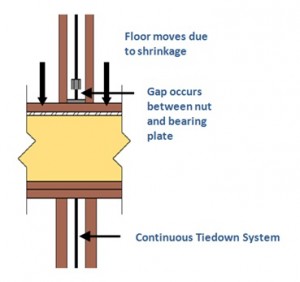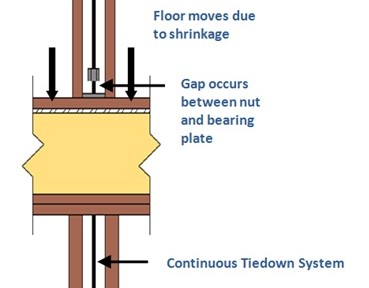Wood is a unique building material because its characteristics are dependent on the environment and its moisture properties, which can vary over time. Often, sawn lumber is delivered to the jobsite with relatively high moisture content. Over the life of the building, moisture content will decrease until equilibrium has been achieved. As moisture content drops, the wood members shrink. Most wood shrinkage occurs during the first six months of the building life and it’s an important design consideration.
is delivered to the jobsite with relatively high moisture content. Over the life of the building, moisture content will decrease until equilibrium has been achieved. As moisture content drops, the wood members shrink. Most wood shrinkage occurs during the first six months of the building life and it’s an important design consideration.
Wood is directionally dependent on anisotropic, meaning it shrinks different amounts in each grain direction. The greatest amount occurs perpendicular to the grain, such as in sole plates, top plates and solid sawn lumber joists. Shrinkage occurring in the longitudinal direction, such as in studs, is very small and often not considered during design. Structural composite lumber (SCL) shrinkage – I-joists, LVL, LSL and PSL – is also usually considered negligible because the initial moisture content is low.
In multistory construction where continuous tiedown systems are used, wood shrinkage can impact shear wall performance because of gaps occurring between the wood and the tiedown system. To compensate for these gaps, and eliminate added shearwall drift due to shrinkage, shrinkage compensating devices are usually the solution.
There are various types of shrinkage compensators available, and each device functions differently in their installed location and the type of loads they obtain. To see animations explaining the various shrinkage compensation devices and how they function in a multi-story building, click here.
– Paul
What are your thoughts? Visit the blog and leave a comment!





After this piece was posted, one of our engineers reminded us that we
have this helpful web tool: a free Wood Shrinkage Calculator, which can be very useful for designers – especially for multi-story structures. The calculator can be found here: http://www.strongtie.com/webapps/woodshrinkage/
Cool calculator, thanks for posting the link.